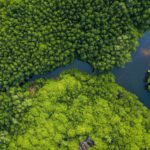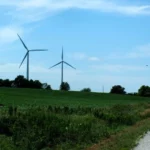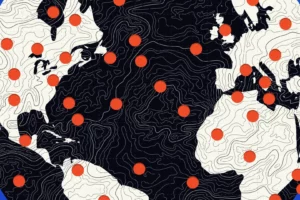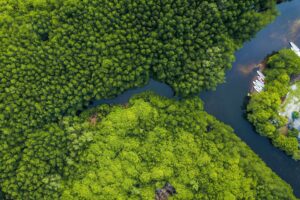- This weekly round-up brings you key climate crisis stories from the past seven days.
- Top climate crisis and environment news: Scientists say 40% of animals in the US are at risk of extinction; China warns of more extreme weather in 2023; Under half of natural disasters in 2022 were insured.
1. News in brief: Top climate crisis stories to read this week
A leading conservation research group says that 40% of animals and 34% of plants in the United States are at risk of extinction, while 41% of ecosystems are facing collapse. NatureServe, which analyses data from its network of over 1,000 scientists across the US and Canada, said the latest findings are its most comprehensive yet.
China’s regions have been warned to prepare for more extreme weather this year after record-breaking temperatures played havoc with the country’s power supplies and disrupted harvests last summer. “Global warming is accelerating… and under the impact of climate change, the climate system is becoming increasingly unstable,” the China Meteorological Administration said.
The US government says it has banned logging and road building in more than half of the 16 million acre Tongass National Forest in Alaska, The New York Times reports. North America’s largest temperate rainforest is home to 400 species of wildlife and stores more than 10% of all the carbon accumulated in forests in the US.
Extreme droughts as well as human activity are causing more harm to the Amazon rainforest than previously thought, CNN reports. Research by an international team of scientists has found that 38% of the existing rainforest has been degraded (damaged and weakened), undermining its ability to store carbon and support nature.
Germany has pledged €200 million ($217 million) to help Brazil defend the Amazon rainforest. The sum includes a donation of €35 million to the Amazon Fund to strengthen a billion-dollar initiative funded by Norway and Germany to protect the rainforest and fight deforestation.
New Zealand’s government has pledged NZ$700,000 ($450,000) in additional funding to help areas affected by severe flooding. The city of Auckland and much of New Zealand’s upper North Island have been hit by record rainfall, which authorities say has been exacerbated at least in part by climate change.
United Airlines Holdings Inc has announced a new joint venture to develop and commercialize sustainable aviation fuel technology that will use ethanol as a feedstock. It says it will proceed with the construction of a pilot plant in 2024, followed by a full-scale facility that could begin commercial operations by 2028.
The UK has announced plans to enhance nature, including a commitment to restore at least 500,000 hectares (1.2 million acres) of wildlife habitat to protect the country’s rarest species. The proposals comprise 70 new projects including 25 new or expanded National Nature Reserves.
2. Less than half of 2022 global disasters insured, says report
Natural disasters and weather events intensified by climate change resulted in a direct economic cost of $360 billion in 2022, with only around 40% covered by insurance providers, according to reinsurance broker Gallagher Re. Of the $360 billion, total insured losses were estimated at $140 billion, with private insurers covering $125 billion and public insurance entities covering $15 billion. This made 2022 the fifth year since 2017 to cross the $100 billion threshold for insurers, the London-based broker said.
Hurricane Ian by far led the cost of damage in the United States. The storm resulted in nearly $55 billion in losses for public and private insurance entities, and an overall economic loss of $112 billion in the United States alone. There were 18 separate weather and climate disaster events in the country last year that exceeded $1 billion each in losses, according to the U.S. National Centers for Environmental Information.

The vast human and financial toll of 11 disasters that occurred in 2022. Image: Gallagher Re
Outside the United States, the costliest event and most consequential from a humanitarian perspective were the floods in Pakistan. A World Bank report estimated a $15 billion economic loss due to direct physical damage, Gallagher Re said. A group of 58 vulnerable countries and the G7 group of rich nations have launched an effort called ‘Global Shield’ aimed at strengthening insurance and disaster protection finance, with Pakistan on the initial list.
3. Test proves that CO2 sucked from the air can be trapped in concrete
A California startup using rocks to soak up carbon dioxide from the air has teamed up with a Canadian company to mineralize the gas in concrete, which could provide a model for fighting the climate crisis. According to US scientists, removing billions of tonnes of carbon dioxide already in the atmosphere, in addition to cutting current emissions, will be necessary to limit global warming.
In an experiment, Heirloom Carbon Technologies delivered about 30kg of CO2 collected from the air around its San Francisco Bay Area headquarters, which was then incorporated into new concrete. The joint effort between Heirloom and Canada’s CarbonCure Technologies was the first time that carbon dioxide absorbed from the atmosphere using direct air capture technology had been secured in concrete, where the CO2 will stay put for centuries, the scientists said.
They acknowledged that capturing and locking down carbon on a global scale will not be easy. Companies like Heirloom will have to build expensive, massive plants capable of capturing millions or billions of tonnes a year. The price of carbon also needs to fall. The US government and industry broadly see $100-a-tonne carbon dioxide as a reasonable price for broad deployment. Heirloom currently charges around $1,000, but says it expects that to fall as its projects grow.
4. More on the climate crisis on Agenda
Understanding where greenhouse gas emissions come from is crucial to helping us curb them. Satellite technology is now helping to identify the sources of emissions and how to better mitigate them.
The US government has pledged to protect the Tongass National Forest, the largest intact temperate rainforest in the world. Professor Beverly Law of Oregon State University says protecting ecological treasures like the Tongass will be critical in combatting the climate crisis.
It’s now inevitable that we will have to learn to live with the effects of the climate crisis. Here are three ways new technologies are proving key in the urgent process of climate adaptation.
Source : World Economic Forum











Add Comment